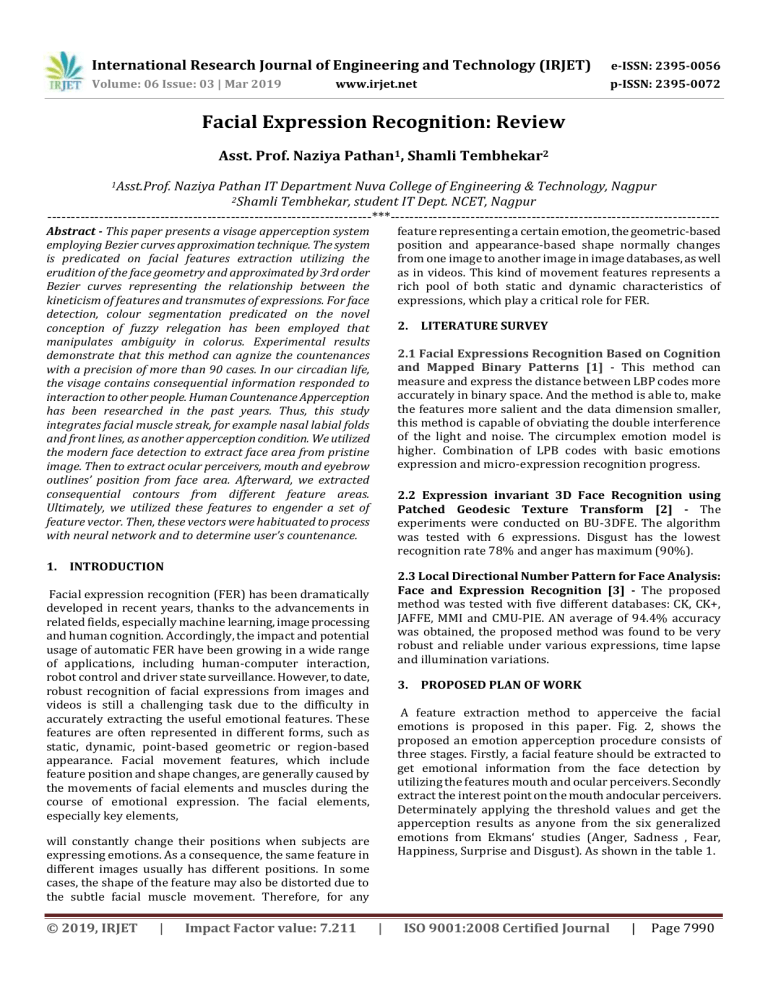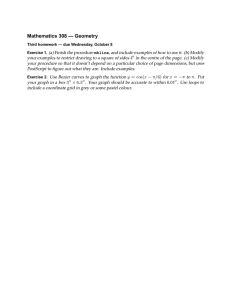IRJET- Facial Expression Recognition: Review
advertisement

International Research Journal of Engineering and Technology (IRJET) e-ISSN: 2395-0056 Volume: 06 Issue: 03 | Mar 2019 p-ISSN: 2395-0072 www.irjet.net Facial Expression Recognition: Review Asst. Prof. Naziya Pathan1, Shamli Tembhekar2 1Asst.Prof. Naziya Pathan IT Department Nuva College of Engineering & Technology, Nagpur 2Shamli Tembhekar, student IT Dept. NCET, Nagpur ---------------------------------------------------------------------***---------------------------------------------------------------------Abstract - This paper presents a visage apperception system employing Bezier curves approximation technique. The system is predicated on facial features extraction utilizing the erudition of the face geometry and approximated by 3rd order Bezier curves representing the relationship between the kineticism of features and transmutes of expressions. For face detection, colour segmentation predicated on the novel conception of fuzzy relegation has been employed that manipulates ambiguity in colorus. Experimental results demonstrate that this method can agnize the countenances with a precision of more than 90 cases. In our circadian life, the visage contains consequential information responded to interaction to other people. Human Countenance Apperception has been researched in the past years. Thus, this study integrates facial muscle streak, for example nasal labial folds and front lines, as another apperception condition. We utilized the modern face detection to extract face area from pristine image. Then to extract ocular perceivers, mouth and eyebrow outlines’ position from face area. Afterward, we extracted consequential contours from different feature areas. Ultimately, we utilized these features to engender a set of feature vector. Then, these vectors were habituated to process with neural network and to determine user’s countenance. feature representing a certain emotion, the geometric-based position and appearance-based shape normally changes from one image to another image in image databases, as well as in videos. This kind of movement features represents a rich pool of both static and dynamic characteristics of expressions, which play a critical role for FER. 2. LITERATURE SURVEY 2.1 Facial Expressions Recognition Based on Cognition and Mapped Binary Patterns [1] - This method can measure and express the distance between LBP codes more accurately in binary space. And the method is able to, make the features more salient and the data dimension smaller, this method is capable of obviating the double interference of the light and noise. The circumplex emotion model is higher. Combination of LPB codes with basic emotions expression and micro-expression recognition progress. 2.2 Expression invariant 3D Face Recognition using Patched Geodesic Texture Transform [2] - The experiments were conducted on BU-3DFE. The algorithm was tested with 6 expressions. Disgust has the lowest recognition rate 78% and anger has maximum (90%). 1. INTRODUCTION 2.3 Local Directional Number Pattern for Face Analysis: Face and Expression Recognition [3] - The proposed method was tested with five different databases: CK, CK+, JAFFE, MMI and CMU-PIE. AN average of 94.4% accuracy was obtained, the proposed method was found to be very robust and reliable under various expressions, time lapse and illumination variations. Facial expression recognition (FER) has been dramatically developed in recent years, thanks to the advancements in related fields, especially machine learning, image processing and human cognition. Accordingly, the impact and potential usage of automatic FER have been growing in a wide range of applications, including human-computer interaction, robot control and driver state surveillance. However, to date, robust recognition of facial expressions from images and videos is still a challenging task due to the difficulty in accurately extracting the useful emotional features. These features are often represented in different forms, such as static, dynamic, point-based geometric or region-based appearance. Facial movement features, which include feature position and shape changes, are generally caused by the movements of facial elements and muscles during the course of emotional expression. The facial elements, especially key elements, 3. PROPOSED PLAN OF WORK A feature extraction method to apperceive the facial emotions is proposed in this paper. Fig. 2, shows the proposed an emotion apperception procedure consists of three stages. Firstly, a facial feature should be extracted to get emotional information from the face detection by utilizing the features mouth and ocular perceivers. Secondly extract the interest point on the mouth andocular perceivers. Determinately applying the threshold values and get the apperception results as anyone from the six generalized emotions from Ekmans‘ studies (Anger, Sadness , Fear, Happiness, Surprise and Disgust). As shown in the table 1. will constantly change their positions when subjects are expressing emotions. As a consequence, the same feature in different images usually has different positions. In some cases, the shape of the feature may also be distorted due to the subtle facial muscle movement. Therefore, for any © 2019, IRJET | Impact Factor value: 7.211 | ISO 9001:2008 Certified Journal | Page 7990 International Research Journal of Engineering and Technology (IRJET) e-ISSN: 2395-0056 Volume: 06 Issue: 03 | Mar 2019 p-ISSN: 2395-0072 www.irjet.net withal be processed. When integrated into an image apperception system or human-computer interaction interface, connected component labelling can operate on a variety of information. 3.1. System Requirements – Hardware Requirements: Processor : Hard Disk Floppy Drive Monitor Mouse RAM Intel Duel Core. : 60 GB. : 1.44 Mb. : LCD Colour. : Optical Mouse. : 512 Mb. Software Requirements: Operating system Coding Language Contrast stretching (often called normalization) is a simple image enhancement technique that endeavors to amend the contrast in an image by ‘stretching’ the range of intensity values it contains to span a desired range of values, e.g. the gamut of pixel values that the image type concerned sanctions. It differs from the more sophisticated histogram equalization in that it can only apply a linear scaling function to the image pixel values. As a result the ‘enhancement’ is less rigorous. (Most implementations accept a grey level image as input and engender another grey level image as output.) STEP 1: INPUT IMAGE The image is taken captured by the web-cam or provided as input through browse. STEP 2: CONTRAST STRETCHING OF THE IMAGE: It performs min max contrast stretching of the image. Find the minimum and maximum values of the pixels in an image, and then convert pixels from the source to destination like ((pixel-min) / (max min))*, fig (a). STEP 3: SKIN COLOUR CONVERSION OF THE IMAGE: In skin color conversion, the skin of the person is converted to white pixel and the rest of the components are converted to ebony pixel. Any RGB digital image can be converted into YCrCB color space utilizing following equation: fig (b). Skin-color Conversion technique is considered as an efficacious implement for face detection because it is invariant to transmutations in size, orientation and occlusion. In this paper, we propose to utilize the YCbCr colour space for two reasons: Y=0.299R + 0.587G + 0.114B Cb = -0.169R - 0.331G + 0.500B Cr = 0.500R - 0.419G - 0.081B -By utilizing YCbCr color space, we can eliminate as much as possible the variation of luminance component caused by the lighting condition. STEP 4: DETECTING CONNECTED REGION: Connected-component labeling is utilized in computer vision to detect connected regions in binary digital images, albeit color images and data with higher dimensionality can additionally be processed. When integrated into an image apperception system or human-computer. -The YCbCr domain is extensively utilized in digital video coding applications. YCbCr is a colour space that disunites the luminance from the colour information. Luminance is encoded in the Y and the blueness in Cb and the redness in Cr. It is very facile too convert from RGB to YCbCr. COMPONENT ANALYSIS STEP 5: BINARY CONVERSION OF THE IMAGE: A binary image is a digital image that has only two possible values for each pixel. Typically the two colors utilized for a binary image are ebony and white though any two colors can be utilized. The color utilized for the object(s) in the image is the foreground color while the rest of the image is the background color. This is an algorithmic application of graph theory, where subsets of connected components are uniquely labelled predicated on a given heuristic. Connected-component labelling is not to be perplexed with segmentation. Connected-component labelling is utilized in computer vision to detect connected regions in binary digital images, albeit colour images and data with higher dimensionality can | Impact Factor value: 7.211 Windows XP. ASP.Net with C# 4. METHODOLOGY CONVERSION OF SKIN COLOR © 2019, IRJET : : | ISO 9001:2008 Certified Journal | Page 7991 International Research Journal of Engineering and Technology (IRJET) e-ISSN: 2395-0056 Volume: 06 Issue: 03 | Mar 2019 p-ISSN: 2395-0072 www.irjet.net STEP 6: EXTRACTING OCULAR PERCEIVERS AND LIPS FROM THE BINARY IMAGE TO DETECT BEZIER CURVES: Left ocular perceiver, right ocular perceiver and the lips are extracted from the binary image and extracted from the image and Bezier curves are drawn accordingly. From the Bezier curves, emotions are detected by comparing its values from the database. scope for the project to explore, for e.g. by improving the Eye-Lip detection procedure, and trying out the project for images taken at different angles and higher resolutions. The general evaluation of the face expressional system guarantees better face recognition rates. Having examined techniques to cope with expression variation, in future it may be investigated in more depth about the face classification problem and optimal fusion of color and depth information. It can be precisely used in security models such as criminal detection, governmental confidential security breaches etc. STEP 7: TO DETECT EMOTIONS OF THE PERSON: Bezier curves are drawn and revered values from the Bezier curves are extracted and compared with values from the database and a congruous emotion is detected. 6. REFERENCES [1] Chao Li, Min Li, Qiushi Wang, Huiquan Zhang, Jinling Xing, Facial Expressions Recognition Based on Cognition and Mapped Binary Patterns, IEEE, 2018, [2] Alexander M. Bronstein, Michael M. Bronstein, Ron Kimmel, Expression invariant 3D Face Recognition, Israel Institute of Technology, 2003. [3] Adin Ramirez Rivera, Jorge Rojas Castillo, Oksam Chae, Local Directional Number Pattern for Face Analysis: Face and Expression Recognition, IEEE, 2011. [4] Institute of Electrical and Electronics Engineers, Regional Registration for Expression Resistant 3D Face Recognition, 2010, ISSN 1556-6013. [5] Maria De Marsico, Michele Nappi, and Daniel Riccio, FARO: Face Recognition against Occlusions and Expression Variations, 2010, IEEE, ISSN 20330315. 5. CONCLUSIONS This project proposes a new approach for recognizing the category of facial expression. We have constructed the expression models by using average Bezier curves from several subjects. In this project, four different facial expressions of more than 20 person pictures have been analyzed. In this project, 3rd order Bezier curve has been used to identify the face outlines and expressions. The adoption of the cubic Bezier curves means only four control points are sufficient to represent a curve. Although this method will be implemented for a few persons, but the experimental results nevertheless demonstrate that our system is reliable if the images represent a distinct view of the faces and are low resolution images. There is a lot of © 2019, IRJET | Impact Factor value: 7.211 | ISO 9001:2008 Certified Journal | Page 7992

